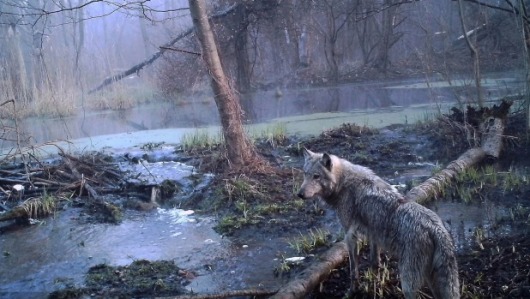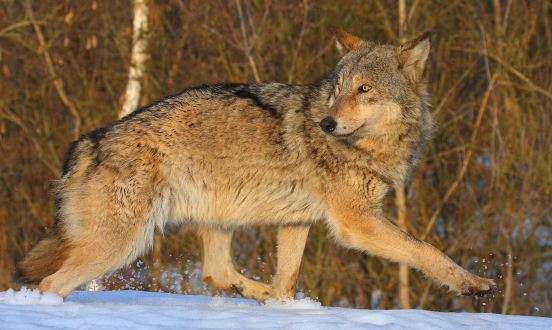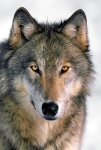“A European gray wolf on the Ukrainian side of the Chernobyl exclusion zone.” Sergey Gashchak/Chornobyl Center
Chernobyl, one of the greatest disasters of the modern age, has turned into a haven for wildlife in just thirty years. How ironic, that a place uninhabited for decades, due to a catastrophic radiation spill at a Ukrainian power plant (which was then part of the USSR), is now a flourishing wildlife refuge, particularly for wolves. The explanation: NO HUMANS!
===
In the eerie emptiness of Chernobyl’s abandoned towns, wildlife is flourishing
The sound was like nothing Tom Hinton had ever heard before: a chorus of baleful wolf howls, long and loud and coming from seemingly every direction in the darkness. The predators yipped and chirped and crooned to one another for what seemed like forever, sending a shiver of awe and intuitive fear down Hinton’s spine.
“It was a primordial experience,” he said, something most of humanity hasn’t felt for tens of thousands of years. “That dates back to when humans were prey.”
It was only possible because of where Hinton was standing, a remote area along the Belarus-Ukraine border that’s been uninhabited by humans for decades.
They all left in the wake of a very different sound nearly 30 years earlier: the massive explosion of the Chernobyl Nuclear Power Plant in 1986, which left dozens dead and drove more than 100,000 people from their homes across a 1,600-square-mile swath of Ukraine and Belarus. These days, abandoned apartment complexes are nothing more than crumbled concrete wrecks. Vines crawl up the decaying walls of old farmhouses and break unintended skylights into their roofs. No one lives in the post-apocalyptic setting.
No one human, that is. Wildlife populations there – shaggy-haired wild boar, long-legged elk, the howling choruses of wolves that so captivated Hinton last August – are flourishing.
“It shows I think that how much damage we do,” said fellow co-author Jim Smith, an environmental science professor at the University of Portsmouth. “It’s kind of obvious but our everyday activities associated with being in a place are what damages the environment.”
“Not that radiation isn’t bad,” he added, “but what people do when they’re there is so much worse.”
The study is the first real census of wild animals in the exclusion zone. It relies on a decades worth of helicopter observations in the years right after the disaster, and three winters of scientists carefully counting animal tracks on foot between 2008 and 2010 in the Belarusian section of the zone.
Though animal numbers were low when scientists first started counting them in 1987 (because no data was taken before the disaster, they can’t tell to what degree the populations were hurt by the explosion), they rapidly rose once humans left the region. Brown bears and rare European lynx – predatory cats the size of a Great Dane with tufted ears and glimmering gold eyes – quickly appeared in the forests, even though they hadn’t been seen for decades before the accident. Wild boar took up residence in abandoned buildings. Forests replaced humans in the villages’ empty streets.
Within 10 years, every animal population in the exclusion zone had at least doubled. At the same time, the kinds of species that were flourishing in the exclusion zone were vanishing from other parts of the former Soviet Union, likely due to increased hunting, poorer wildlife management and other economic changes.
By 2010, the last year of the on-foot census, the populations for most species were as large as in any of Belarus’ four national parks. For one species, the wolves, the population was seven times bigger.
This indicates to researchers that chronic exposure to radiation from the explosion has had no impact on overall mammal populations. Whatever fallout may have come from the initial explosion was completely offset by the benefits of life without humans.
This doesn’t mean that the zone isn’t dangerous, Hinton stressed. He and his colleagues didn’t study the individual- and molecular-level damage caused by lingering contamination. While whole populations aren’t dying out, individual animals might be getting sick. And surveys have shown that the soil in areas close to the reactor site still exude radiation.
But, “the environment is very resilient,” Hinton said.
The presence of wolves is particularly telling. As apex predators, they are a sign of the health of the entire ecosystem – if they’re flourishing, that means that every other level of species, from elk and deer on down to insects and plants, must also be healthy.
Another team of researchers is currently using camera traps to count wildlife on the Ukrainian side of the exclusion zone. Nick Beresford, a radioecologist at the National Environment Research Council in the UK, said that their work won’t be done until the end of the year, but he expects to reach the same conclusions as those working in Belarus.
Beresford praised the Current Biology study and its findings: “People have said before that wildlife in the zone is flourishing, but those accounts were rightly criticized as anecdotal,” he said. “This is the first study to really back it up with science.”
Walking around the exclusion zone is like being in “a national park without the people,” Hinton said. The forests are nearly pristine, the animals abundant. What relics of human presence do remain have been almost entirely reclaimed by nature.
Even the Soviet city of Pripyat in Ukraine, which once housed tens of thousands of workers at the Chernobyl plant, has been subsumed by trees.
“When I was there 15 years ago, it looked like a city with some trees growing in it,” recalled Smith. “Now it looks like a forest with some buildings in it.”
For Hinton, who is currently studying the effects of the 2011 Fukushima nuclear disaster in Japan, the impact is both astounding and sobering.
“It’s an amazing experience from a wildlife perspective, but it’s also a sad experience because you see homes that have been abandoned and you imagine the people’s lives that have been disturbed,” he said. “It’s sad to see the houses and the cars and the baseball bats and you envision the life that people had to drop and leave. But you also see wild boar running around and you don’t see that as soon as you leave the zone.”
===
Wolves Have Taken Over Chernobyl
ELK, DEER, WILD BOAR ALSO ENJOYING LIFE FREE FROM HUMAN HABITATION
Posted Oct 6, 2015 7:32 AM CDT
“Wolf populations are seven times greater near Chernobyl than in nearby uncontaminated nature reserves. (Valeriy Yurko/T.G. Deryabina)”
http://www.newser.com/story/213986/wolves-have-taken-over-chernobyl.html
===
Radioactive Wolves
===
Top Photo: Courtesy Sergey Gashchak/Chornobyl Center
Bottom Photo: Courtesy Valeriy Yurko/T.G. Deryabina
Video: Courtesy Youtube
Posted in: gray wolf, biodiversity
Tags: Chernobyl, wolves flourish in Chernobyl, radiation, Ukraine, biodiversity









 Boulder White Clouds Council
Boulder White Clouds Council Exposing The Big Game
Exposing The Big Game Footloose Montana
Footloose Montana Friends of the Clearwater
Friends of the Clearwater Lockwood Animal Rescue Center
Lockwood Animal Rescue Center Louise du Toit
Louise du Toit LUPUSLAETUS
LUPUSLAETUS Mercy For Animals
Mercy For Animals Northern Idaho Wolf Alliance (NIWA)
Northern Idaho Wolf Alliance (NIWA) Predator Friendly®- Because Wildlife Matters
Predator Friendly®- Because Wildlife Matters Project Coyote
Project Coyote Project: Wolf
Project: Wolf The Nature Conservancy
The Nature Conservancy The Ravensong Group
The Ravensong Group WildEarth Guardians
WildEarth Guardians Wisconsin Wildlife Ethic-Vote Our Wildlife
Wisconsin Wildlife Ethic-Vote Our Wildlife Wolf And Wildlife Studies: Jay Mallonee (Independent Wolf Biologist)
Wolf And Wildlife Studies: Jay Mallonee (Independent Wolf Biologist) Wolf Song of Alaska
Wolf Song of Alaska Wolves in english ! Les loups en anglais !
Wolves in english ! Les loups en anglais ! WWP's Gray Wolf Page
WWP's Gray Wolf Page Yellowstone To Yukon Conservation Initiative
Yellowstone To Yukon Conservation Initiative
Reblogged this on Exposing the Big Game.
LikeLike
Guess that verdict is in: Human beings are worse than nuclear waste.
I wish it didn’t take a catastrophe to give wildlife a chance.
LikeLiked by 2 people
🙂 I had to give that a Like.
Let’s hope the fear of radioactivity has very long legs.
LikeLiked by 1 person
Reblogged this on Sherlockian's Blog.
LikeLike
Nature took over, as always, a tribute to all!
LikeLiked by 1 person
God bless the wolves. They have been here since the Neanderthals. There are pictures of ‘dog’ and man found carved in prehistoric caves. What makes this dumb-butt government and the mindless jerks with their wolf slaughtering ‘apparel’ ever think that their blood missions to end wolf will be of any success?! “Long live the wolf!”
LikeLiked by 3 people
Since the first comprehensive look – video – came online a few years ago, I’m hoping that scientists will have taken the op to study the ecosystem, trophic effects, etc. without the human influence.
Hunters DO go in there and shoot things, though.
Little historical overview:
the slav public don’t very much like wolves, never having the culture to react correctly over centuries, with the monster autocracy & and peasantry (serfs were required to stay on the pieces of land, traded among the nobility – slaves) never having used anything except guns to interact, and those relatively rarely, in winter, wolf-time.
Without a history of protecting their domestics with dogs or close guarding, Russia (the Rus ruled between the Nordic lands and the Black Sea – except for the intermittent horse-peoples irruptions and invasions) developed a LARGE sedentary population in the world of the wolf.
So, when the big ungulates began to be excluded/overhunted, the wolves had no one to eat.
Because the sprouting Russian serf villages of the forests, and the turning of Ukraine steppe into cereal production used horses (The Scythians used horse-pulled wagons, and the Finno-ugrics used tame caribou – reindeer – to pull sleighs).
Asian wolves are ancient predators of caribou and the small horses from which big one were bred; the wolf’s natural prey were the actual goals of wolves there.
The people feared the wolf packs following the strangely handicapped horses and caribou, those ancient prey.
Because the North – the cold country – does not tolerate high populations of sedentary species (remember caribou, elk, moose, deer, everything with sense, migrates in high latitudes), the wolf would of course come into hard times with the way humans proliferate and eradicate wild food-things.
So, another aspect of some human cultures, the failure to closely oversee the young, is prominent; the hungry wolves had to take (just as they have to take human young right now in northern india. The more indigenous Himalayan peoples, as you may know, DO use large dogs, DO oversee their young closely, unlike the people who do not know the wild earth so well – india the indus, etc. has been overpopulated for millennia, and this seems to lead to less protective practices for individuals).
And of course, humans have strong outrage, perhaps especially when they take NO precautions – perhaps, like the Euroranchers of the West, (that’s ranchers of euro descent – the heart of all problems,as they had no wildland experience, but only guns as answer for everything, when they came to North America), even MORE rage when confronted with native flora and fauna.
Due to the baseline relationships of predator and prey having been destroyed by these proliferating humans, with both Russian Eurasia and with North America having been invaded by agriculturalists and pastoralists already equipped with the destructive answer – guns -and without the background of seeing or caring about the complex, beautiful interacting members of an ecosystem – ignoring the world they invaded, bringing their own limited utilitarian farming minds (my grandfather was a farmer – none of them escape a huge self-interest bias, not even the best), we know little about the REAL diversity.
Only the passenger pigeon, eskimo curlew, bison, pronghorn, words to the effect that elk were innumerable, caribou extending into upper Minnesota, the 3 or more salmon runs extending deep into the continent yearly, millions of songbirds lost, only some indicators are ever spoken of.
A tiny piece of the real world, then, with a look into the future when seeing Pripyat, the emptied city retaken by the living world.
I hope to be here when Beauty overtakes other excessive cement excretions, on this continent.
In latest news, one long-wandering wolf, OR-3, last detected near Prineville OR in 2011, is strolling into the area of the Upper Rogue River – a big wild area of the southern cascades, with scents leading to OR-7’s and the Black California wolf families.
Survivors.
The Russians have a saying:”The wolf is fed by his feet” meaning, that they both wander, and are determined, among other ideas.
A few of us are the children who have heard the call of the wolf. My own footsteps were steadied in mountains and rolling hills and forest in darkness.
I cannot remember to whom I have told tales of the wolf’s tail flagging at the edge of vision, the sinuous, snakelike curving of my Brother’s body among tight trails, barely visible, yet keeping me from stumbling in the darkness.
Since you have now more than once raised the etemmu of Henry Beston’s calling, figments perhaps only of the human mind, when the Wolf is instead so innocent and knowing,
“Our fantastic [meaning: filled with fantasy] civilization has fallen out of touch with many aspects of nature, and with none more completely than with night.”
I still love the night, as the other animals must.
Some olding innocent whom the collarers call OR-3, is another, who will be fed that most important food, love, wending.
Or not.
Yet he will follow the path of wisdom and of innocence, coming down from the North, to where my Brother sleeps, and where the new young will greet morning.
LikeLike
here’s one more location:
http://www.theguardian.com/environment/2015/feb/06/living-in-minefield-wolves-northern-israel
Living in a minefield: the wolves of the Golan Heights
In the Golan Heights, a dangerous minefield provides an unlikely wildlife reserve where wolves are thriving
The landmines and the tensely patrolled militarised zone make it a dangerous and forbidding place for humans, but a sanctuary for the wolves. “I have watched the wolves running towards the minefields, only to slow down to an easy trot when they pass the fence,” Itamar explains. “If the mines go, so will the wildlife.”
LikeLike